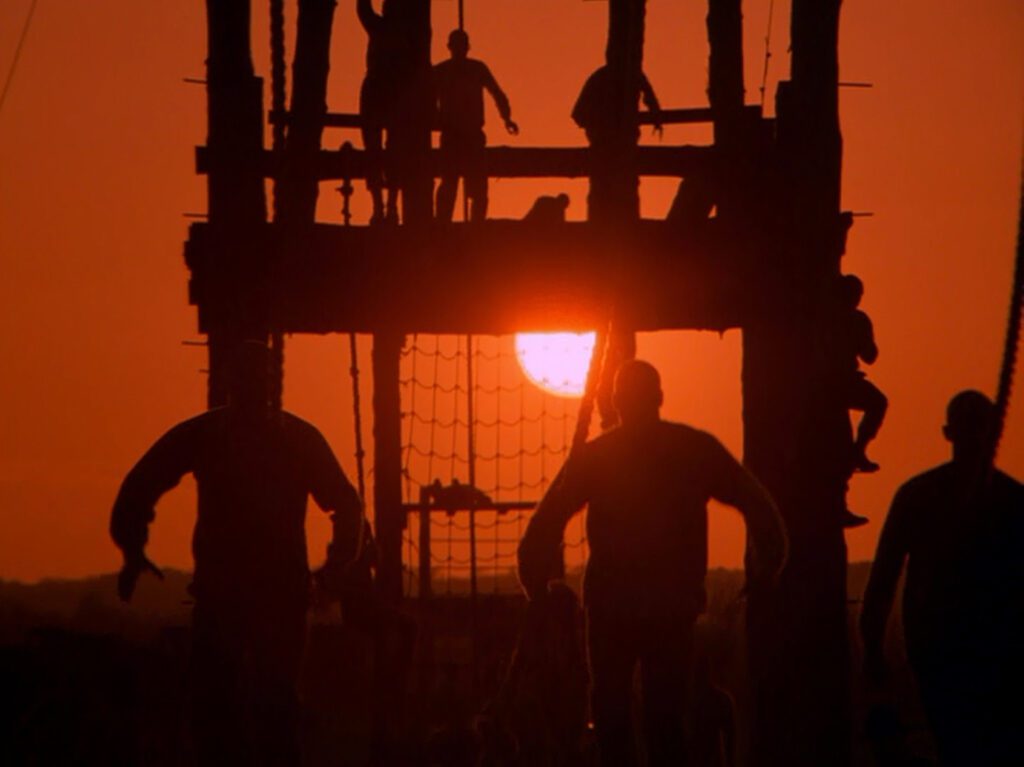
Full Metal Jacket
1987, directed by Stanley Kubrick
At the climactic moment of Full Metal Jacket, Private Joker shoots a wounded young Vietnamese girl, the sniper who killed three of his mates. The shot is 70 seconds long, but its only significant movement is the slight rotation of Joker’s body as he slowly turns one way then the other to squeeze the trigger. Joker is wearing a peace symbol on his shoulder, but as he turns, his lapel slowly obscures the button. Twenty seconds into the shot he fires the bullet, and at that exact moment – at that moment only, before he turns back – the peace symbol is fully eclipsed.
The peace button is paired with a “Born to Kill” inscription on Joker’s helmet. At the mass grave near Phú Bài a colonel demands to know what Joker means by wearing both messages, and he gives a vague answer about the dual nature of man. But when the peace symbol is eclipsed there is no dual nature in him; he has finally fulfilled his wish “to be the first kid on my block with a confirmed kill.” It’s ironic that his confirmed kill is so far from the heroic act he imagined every time he put on his war face. Joker imitates John Wayne from the start of boot camp up to the combat zone, but instead of becoming a tough guy he winds up killing an injured adolescent girl who is begging him to shoot her.

The culmination of Joker’s wish is not the only irony in the sniper scene. The incessant lewd banter and sexual mockery in Full Metal Jacket stems from the Marines’ desire to make men out of their recruits so they’ll fight better. Gunnery Sergeant Hartman constantly challenges the trainees’ masculinity, from calling them “ladies” and “sweetheart” to making them march through the barracks yanking on their crotches. The young men absorb the lesson well, learning quickly to measure their manhood against each other. Yet all these displays of testosterone avail them nothing once they get to Vietnam. The first thing we see there is a prostitute distracting Joker and Rafterman while a thief grabs their camera. Their masculinity proves more of a weakness than a strength in Vietnam, and their most deadly enemy, the feared sniper, turns out to be a little girl.
Both Joker’s wish to kill and the military’s emphasis on masculinity fall flat in the end, casualties of a pattern of unintended consequences which governs the plot of Full Metal Jacket. The idea that it would be glorious to come home with a confirmed kill, or the idea that the United States can protect its global interests by being more macho than its enemies, is consummate arrogance. If it’s more of a surprise to see these beliefs fail in a movie than to see them fail in real life, that’s only because so many war movies cater to personal fantasies like Joker’s or nationalist fantasies like those of the hawks responsible for the Vietnam War.
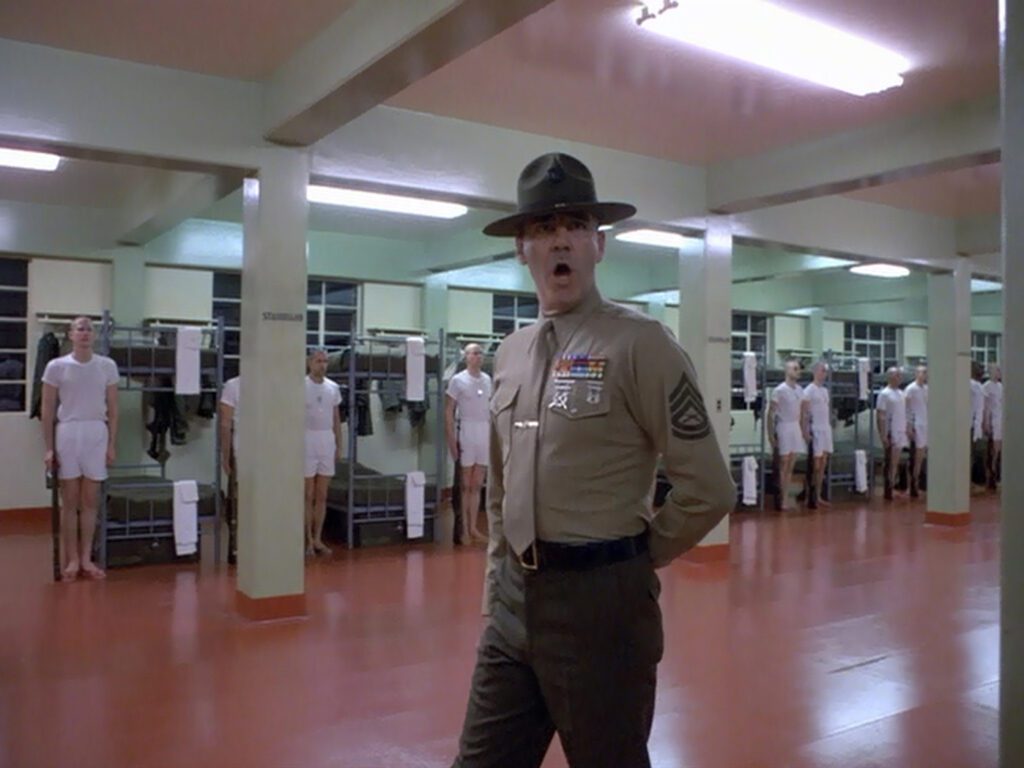
Full Metal Jacket is conspicuously divided into two sections: the training sequence on Parris Island in South Carolina, and the war sequences in Vietnam. Although the basic two-part structure is obvious, the parallels between the parts are less so. The sections are unequal in length, roughly 45 and 67 minutes respectively, each consisting of several vignettes that build to a scene of horror. Both sections include a prayer scene – the soldiers’ mock bedtime “prayer” to their rifles and the purported prayer of the dying sniper. Each spans the most important holiday of its respective country, Christmas and Tết. Both feature references to the Virgin Mary, first from the lips of Sgt. Hartman and second from the soldier who used to play football for Notre Dame. And the denouement of each half mentions Mickey Mouse: Hartman charges into the bathroom bellowing “What is this Mickey Mouse shit?”, and the movie ends with soldiers singing the Mouseketeers’ anthem.
The two climaxes are more alike than they appear to be. Both are accompanied by eerie electronic music scored by Stanley Kubrick’s daughter Vivian (credited under the pseudonym Abigail Mead), each musical theme having appeared once previously – the score for Private Pyle’s murder-suicide simulates deep breathing and appeared in the hazing scene, while the music in the sniper’s finale, which sounds like giant metal plates swinging on a creaky hinge, had appeared over the mass grave. Each of the two climaxes also shows the agonized face of its main subject, Pyle then Joker, in a dark room with flickering light.
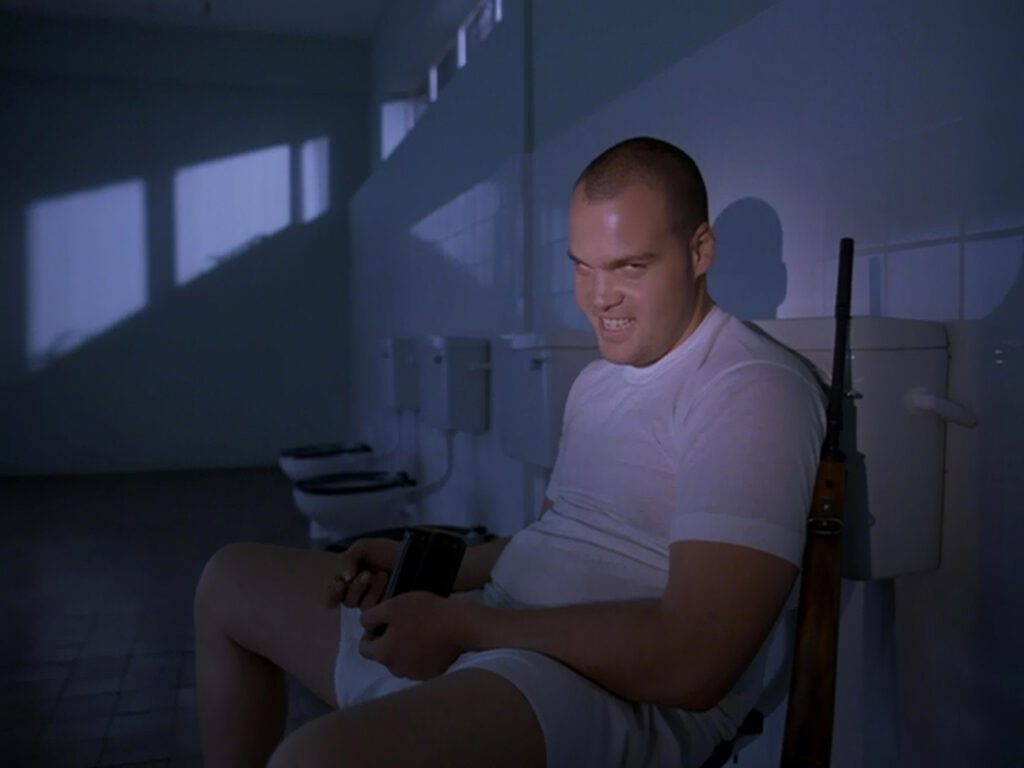
The title of Full Metal Jacket alludes to both climaxes. The term describes the metal-encased bullets with softer, heavier lead cores used as live ammunition in a military rifle. It’s also a metaphor for young men hardened on the outside by their training but dull and soft on the inside, as Joker and some of his fellow recruits prove to be. In both climaxes, again following the law of unintended consequences, the jacketed bullets fail to achieve their intended military use: Private Pyle kills a U.S. Marine, and Private Joker’s rifle jams when he most needs it. When he finally shoots the sniper the act serves no tactical purpose. Although he justifies the killing as a merciful coup de grâce, the logic that binds the two climactic scenes together casts suspicion on his motive.
One section ends in a murder-suicide, the other in a mercy killing – or so it appears. Joker doesn’t snap like Pyle does, but his urge to become a killer should hardly pass for sanity. The eclipsed peace symbol tells us that shooting the girl is, to Joker, more the culmination of a murder fantasy than an act of kindness. In the following coda while marching to the Mouseketeers song, instead of reflecting on the life he snuffed out, he sinks into juvenile sexual fantasies and dull contentment. His words echo Pyle’s: he too is living in “a world of shit” but he’s happy there. The movie tells us, in other words, that he’s killed off his own soul. He’s committed a murder and a suicide – Joker’s ending is no better than Private Pyle’s.
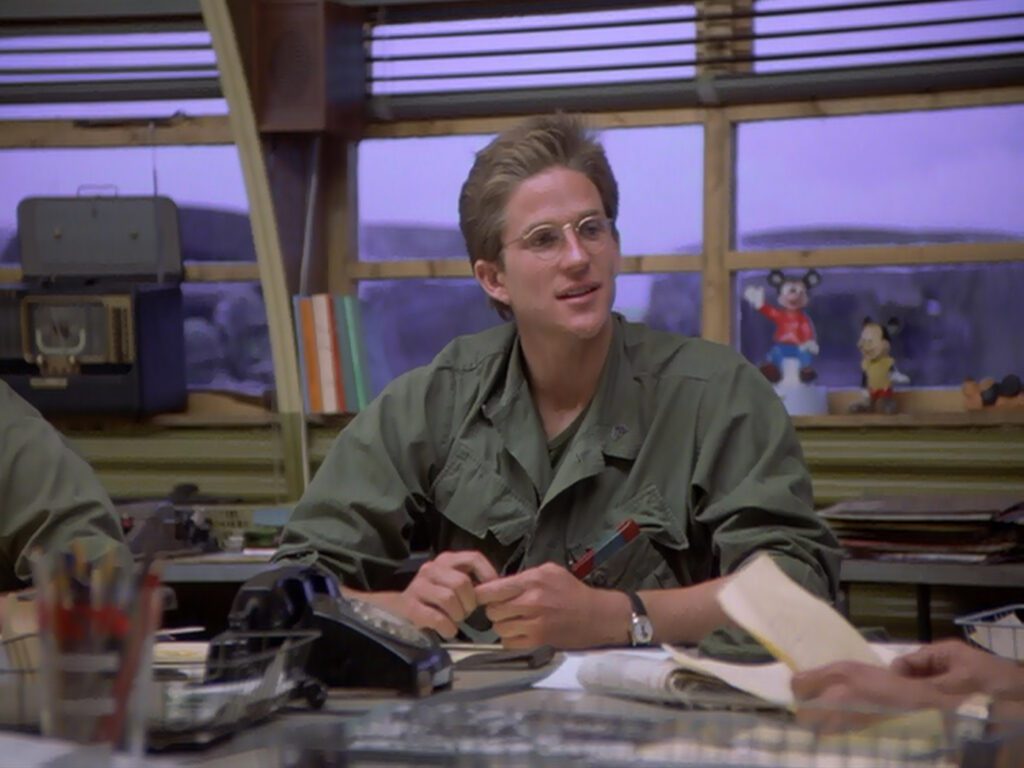
The movie is not interested in the usual questions of morality that war films often raise. Unlike Platoon, which won the Oscar for Best Picture the year before, Full Metal Jacket doesn’t pretend that the soldiers were innocent going into Vietnam. Nor is it preoccupied with geopolitical questions; it doesn’t ask which side is preferable. Of course it acknowledges the inhumanity of the Vietnam War; the door gunner in the helicopter commits war crimes with impunity, gleefully shooting helpless women in rice fields while Joker and Rafterman are too cowardly or too uninterested to interfere. The scene at the mass grave acknowledges similar crimes on the other side; but these incidents are not foregrounded, they’re part of the context. Instead of particular arguments about the rights and wrongs of a specific war, Full Metal Jacket attacks the general logic that leads nations to war, sometimes in spite of good intentions, putting the blame on a misplaced faith in predicted outcomes.
The two-part structure invites audiences to compare expectations of war with the realities of war. In nearly every way the reality proves messier and less fortunate than what anyone plans for. Joker imagines the experience will be like a Hollywood Western. The drill sergeant imagines he’s serving his country by making his recruits more manly. Even the orderly boot camp is ruled by unforeseen consequences, as Pyle breaks down and kills Hartman. Hartman admits with perverse pride that the Marines produced Lee Harvey Oswald and Charles Whitman; he himself can be added to their list of failures.
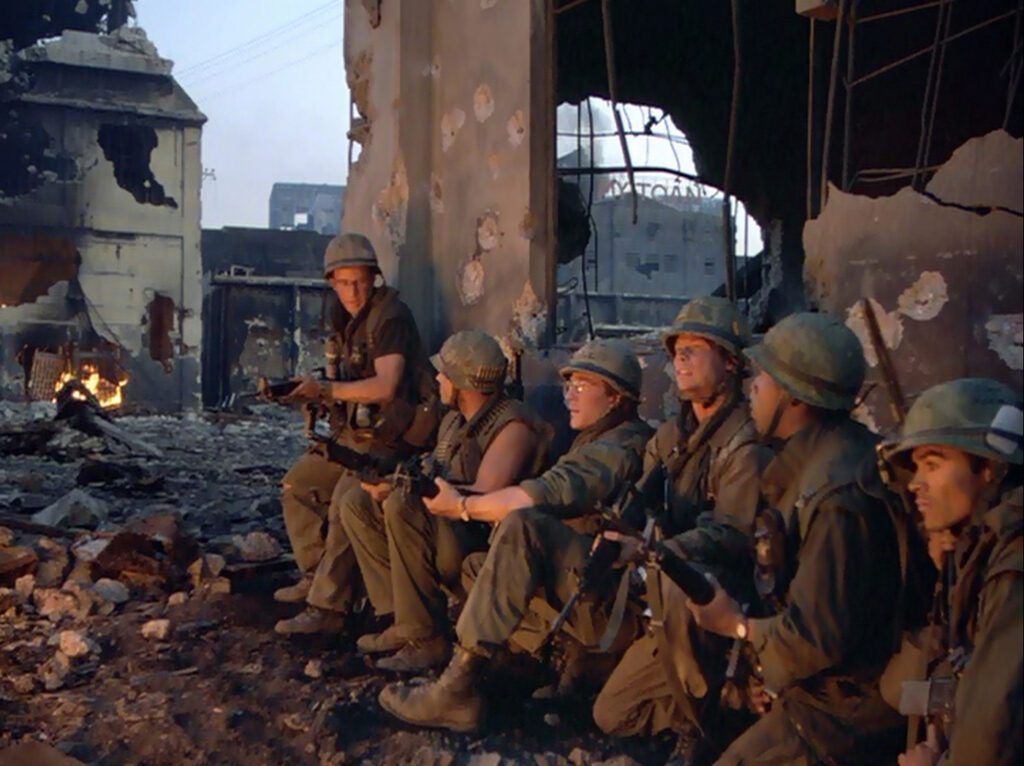
Although Full Metal Jacket never mentions the outcome of the Vietnam War, it was understood in 1987 that anyone would know the American mission had failed. The arrogance that leads to unpredictable outcomes in the particulars of the war fares no better when the total endeavor of a war is analyzed. Whatever merits there might have been in fighting communism, America’s war left a horrific legacy in Southeast Asia, including the Khmer Rouge genocide in Cambodia which sprang in 1975 like a contagion from the Vietnam War just as the Islamic State would spring out of the Iraq War in 2014. Full Metal Jacket warns us that war tends to produce unexpectedly dire outcomes that outweigh any justifications for entering it willingly.
CONNECTIONS:
Chinatown – Critique of the arrogance behind the Vietnam War, and of the assumption that it could be fought neatly
The Shining – Murderousness of the United States; Mickey Mouse reference
Black Hawk Down – Messiness and unpredictability of war; asymmetrical urban warfare